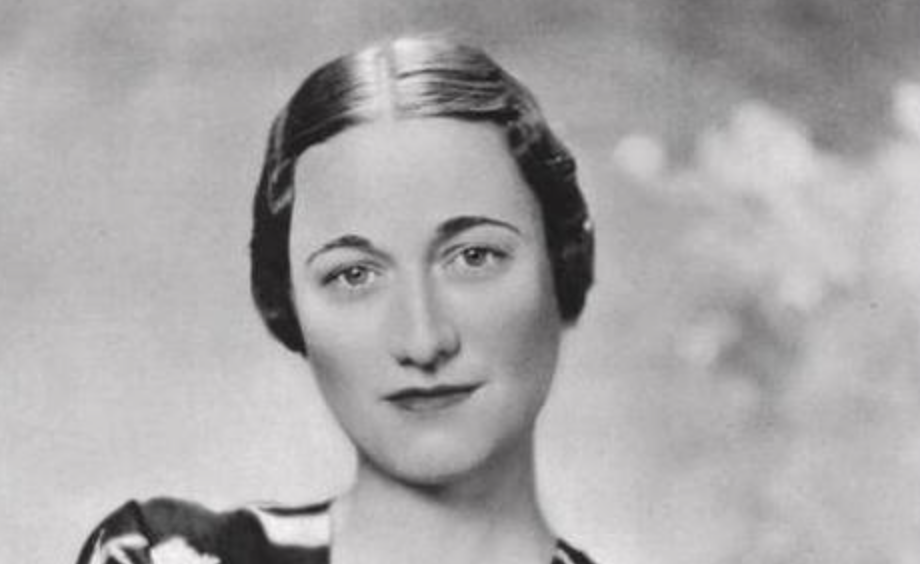
Bessie Wallis Warfield – more commonly known as Wallis – was born 19 June 1896 in Blue Ridge Summit, Pennsylvania, to Teackle Wallis Warfield and Alice Montague.
Wallis grew up in Baltimore, Maryland. Her father died shortly after her birth from tuberculosis which left Wallis and her widowed mother partly supported by their wealthier relatives.
In November 1916, Wallis married U.S. naval officer Earl Winfield Spencer Jr. in Baltimore, but periods of separation led the couple to divorce in December 1927.
Less than a year later, on 21 July 1928, Wallis married Ernest Simpson, an American-born British shipbroker in London. The couple divorced on 3 May 1937. The two would remain friends with Wallis sending him flowers when Simpson was in the hospital for surgery. Simpson would also later offer advice and clarification when his former wife was working on her memoirs.
It was during her marriage to Simpson that Wallis met Edward, the then Prince of Wales. In January 1934, while Lady Furness (mistress of the Prince of Wales) was away in New York City, it was alleged that Wallis became the Prince’s mistress. Edward denied this to his father despite staff seeing the two in bed together, as well as “evidence of a physical, sexual act.”
According to Wallis, it was during a cruise on Lord Moyne’s private yacht in August of 1934 that Wallis fell in love with Edward. At an evening party at Buckingham Palace, Edward introduced Wallis to his mother; his father was outraged by the situation primarily because divorcées were typically excluded from court.
A year later, it became particularly alarming as Edward showered Wallis with money and jewels. In 1935 and 1936, the Prince (and later King) was seen on holiday with Wallis in Europe leading Edward’s courtiers to believe that Wallis was interfering with his royal duties.
Embed from Getty ImagesHowever, things did not go as smoothly as one may have hoped. The King’s desire to marry a woman who had two living ex-husbands threatened a constitutional crisis in the United Kingdom and the Dominions. Ultimately, Edward would abdicate in December of 1936 to marry “the woman I love.”
After the abdication, the former monarch was created the Duke of Windsor by his brother and successor, King George VI. Wallis finally wed Edward on 3 June 1937 in France and became the Duchess of Windsor. However, she was not allowed to share her husband’s style of “Royal Highness,” and no member of the Royal Family attended.
Embed from Getty ImagesThe Duke and Duchess lived in France during the pre-war years. In 1937, the couple made a high-profile visit to Germany where they met with Adolf Hitler. After the visit, Hitler notably said of the Duchess, “She would have made a good Queen.” The trip led to government suspicions that the Duchess was a German agent – a claim she often ridiculed in her letters to the Duke. United States FBI files compiled in the 1930s also portrayed Wallis as a Nazi sympathiser.
Embed from Getty ImagesIn August of 1940, as German troops invaded France, the Duke and Duchess travelled to the Bahamas by commercial liner, where Edward became Governor. During her five years as the Bahamas’ First Lady, Wallis actively worked for the Red Cross and the improvement of infant welfare. Edward’s tenure as Governor of the Bahamas ended after the end of the Second World War, and the couple returned to France.
By the 1960s, the Windsors were in more contact with the Royal Family. When the Duke had eye surgery in London in 1965, The Queen and the Duchess of Kent visited them. The Duke and Duchess also attended the memorial service for the Duke’s sister, the Princess Royal, that same year in Westminster Abbey. Two years later, they helped the Royal Family celebrate the centenary of Queen Mary (Edward’s mother)’s birth; they joined The Queen for the unveiling of a plaque in Queen Mary’s honour.
On 28 May 1972, Edward died from throat cancer, and his body was returned to Britain to lie in state at St George’s Chapel at Windsor Castle. The Queen invited the Duchess of Windsor to stay at Buckingham Palace while she was in the UK for the funeral on 5 June. The Duke was buried in the Royal Burial Ground behind the Royal Mausoleum of Queen Victoria and Prince Albert at the Frogmore Estate; until 1965, the Duke and Duchess had planned to be buried in Baltimore with the Duchess’s father before an agreement was reached with the Royal Family.
The Duchess, who suffered from dementia, outlived him by over ten years and died on 24 April 1986 at her home in the Bois de Boulogne in Paris at the age of 89. Her funeral was held at St George’s Chapel on 29 April and was attended by her two surviving sisters-in-law, the Queen Mother, and Princess Alice, the Duchess of Gloucester. The Queen, the Duke of Edinburgh, and the Prince and Princess of Wales also attended the funeral and burial. The Duchess was buried next to her husband.

